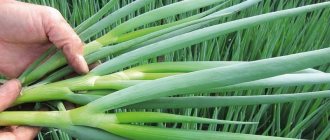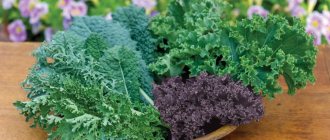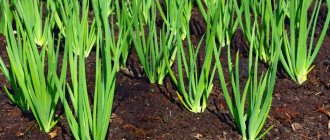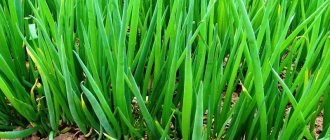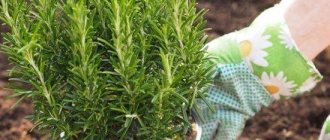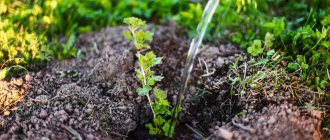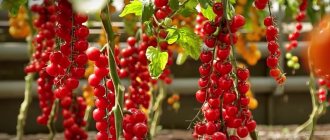Variety selection
Growing from seeds is beneficial for several reasons:
- varieties are presented in a large assortment;
- plants obtained from seeds do not produce arrows and are less susceptible to disease;
- The cost of seeds is low; you can plant several varieties and then choose the most successful one.
When choosing a variety, be guided by the climatic conditions of your region, ripening time and taste of the bulbs.
Unpretentious and easy-to-care varieties are suitable for open ground: Strigunovsky, Bessonovsky, Stuttgarter Riesen.
Globus, Exhibition, Carmen, Kaba show higher yields, but you will have to put in more effort to grow them.
Here is a brief description of popular varieties for open ground:
- Hybrid Esaul . High-yielding mid-season onion. The heads are round, medium size - 150 g. The pulp is juicy, the taste is semi-sharp.
- Exhibition. A popular variety of Dutch selection. Large-fruited and high-yielding. The weight of the bulbs is 600-800 g. Resistant to diseases and temperature changes. The pulp is juicy and sweet, good in salads.
- Strigunovsky. Mid-season variety with medium-sized bulbs, weight - 80-100 g. Keeping quality is good. The pulp has a pungent taste with bitterness.
- Bessonovsky. An unpretentious small-fruited variety. The average weight of the bulbs is from 45 to 55 g. The shape is round, the flesh is juicy and sharp. Stores well for up to 9-10 months.
- Black Prince . A productive variety, burgundy-colored bulbs. The heads are small - 60-70 g. The pulp is juicy with a bitter aftertaste. Suitable for winter storage.
- Moldavian. Unpretentious and disease resistant. The average weight of the bulbs is 50-80 g. They store well and are suitable for growing for commercial purposes.
- Siberian annual. Cold-resistant, produces a harvest already in the first season. Medium-sized round heads - 120-130 g. The taste is semi-sharp. Keeping quality is high.
You can collect onion seeds yourself. To do this, several large bulbs are planted in the spring. Black seeds are collected from flower stalks formed in summer in autumn.
Culture propagation
Special black onions are just seeds from which you can get regular onions. In 90% of cases, for ease of work, onions are sown with seeds (they are black in color). They are obtained from inflorescences (umbrellas) that appear at the ends of the arrows.
Onion Nigella seeds for propagation
If onions are needed in the future to produce greens, then bolting should not be allowed. This is due to the fact that the formation of the bow head, from which the arrows should come out, will be disrupted. Reproduction of the crop in the correct sequence should occur as follows:
- in the first year, seeds are sown - onion sets are formed (seed material for subsequent plantings);
- in the second year, the seedlings are planted and the bulb uterus is formed;
- in the third year, the queen is planted - seeds can be obtained from it.
The stages of reproduction are simple, but take a long period of time. A similar method is used in the middle zone, the Moscow region. The southern regions use a slightly different method: sowing is done in the fall, and the harvest is harvested after the snow cover has melted. In order to protect the plantings from frost, ordinary straw is used.
Nigella onion can be sown as seedlings, which will then be moved to open soil. The most suitable method of propagating a bulbous crop is determined by the characteristics of the area, soil and climate. For the middle zone, spring is preferable, since complete preparation of fertile soil in winter is impossible. The southern regions also choose autumn as the time for planting, since the winters here are milder. In the autumn and spring periods, digging and loosening of the soil and application of fertilizers are carried out.
In order to plant, you need to save a large number of seeds or bulbs suitable for further use. That is why planting material must be stored in special conditions: in a cool room, protected from water and light. Specimens with damage or signs of rot must be removed.
With the onset of weather conditions suitable for planting, the bulbous material must be brought into a warm room (temperature values not lower than 25 degrees). The next day, you need to carry out disinfection with a solution that will contain table salt, potassium permanganate and copper sulfate.
Important! It is recommended to prepare the soil in the fall so that only fertilizing is done during the planting and maintenance period. Disinfection is carried out 14 days before planting onions.
Sowing nigella onions in prepared open ground is carried out in the spring. It must be remembered that there is no need to press down the soil from above. The sowing depth should not be large. The subsequent maintenance process is simple: you need to carry out weeding (every day) and watering as necessary. All manipulations must be carried out in the morning or evening hours, when the plant has active biological processes that accelerate growth and development.
Sowing seeds
If you choose the method of sowing seeds, then the first thing you need to do is prepare the soil, dig it well, make it soft and loose. Then fertilizers or top dressing are applied (if the soil was fertilized last season or beets or cabbage were previously grown in this area). Loosening is required because the onion has a weak root system: if the soil is heavy, it will not be able to break through it or grow into a strong plant, the turnip (if it can form) will be small and show poor storage data. Even high-quality planting material will not be able to fully germinate in unprepared soil - this must be taken into account. Good soil:
- moistened (but not flooded, since excess moisture will negatively affect the root system of the plant, which is considered weak);
- nutritious (fertilizers applied in advance will help improve this indicator, and fertilizing will help maintain optimal conditions);
- light in structure (not clayey).
It must contain all the necessary nutrients. Ideal predecessors are melons, legumes or representatives of the nightshade family. Good soil is loam or sandy loam, here nigella onions can quickly take root and begin to develop without spending a lot of effort breaking through the top layer at the time of seed germination.
When preparing the site for planting, it is recommended to add humus or compost at the rate of 5 kg per 1 m².
Important to consider! The use of fresh manure to fertilize onion plantings is prohibited, as the plants will be burned, but rotted manure should be used in moderation. This is required so as not to artificially prolong the growing season.
Important advice for those who decided to plant onions: if in the previous year such an event as liming the soil was carried out, then it is recommended to postpone the cultivation of this crop until the next season, the current one will be preparatory, and grow the plant itself after another 1 year. It turns out that during the summer and winter the soil is fertilized and rests, then it is prepared for the fact that onions will be grown in it.
Other suitable crops can be planted beforehand. In the spring of the year of planting onions, it is necessary to carefully loosen the fertile soil, it is necessary to crush the lumps in order to saturate the soil with oxygen. You can add ammonium nitrate in small quantities at the rate of 20 g per 1 m². Other types of fertilizer should be applied extremely carefully and consult with experienced gardeners before the procedure.
Caring for emerging seedlings involves weeding. It should be frequent, since weeds and grasses take a significant part of the nutrients and oxygen. It needs to be done in the morning. Watering is also required - the soil should not be too dry. You can also fertilize 1-2 times per season, especially if fertilizers have not been applied previously.
Planting seedlings
If you need to germinate seeds and then plant onion seedlings, the plant will go through all stages of development in one season (until the time of harvest - spring-autumn). In this case, you will first get a small head (set), which will then form into a full-fledged onion. To plant using seedlings, you need to select seeds of annual onion varieties. Seeds should be sown at home in containers in March-April, then in the spring, before planting, prepare the area and place the seedlings.
For the first stage of cultivation, both sprouted and dry seeds are used. At home, you need to control humidity levels. If dry seeds were used, they will also germinate in 90% of cases with proper care. The suitability of seedlings is if they are powerful, richly green, and strong. It needs to be planted in moist and dug soil.
The seedlings need to be watered regularly, avoiding drying out. If cultivation is carried out on a balcony or terrace, then from February to the end of March, film can be used to achieve an optimal microclimate. When the temperature passes the mark of 5-7 degrees, it can be removed.
Sowing dates depending on the growing region
The timing of sowing onion seeds depends on the chosen growing method (direct sowing or through seedlings) and the climatic conditions of the region.
In Siberia and the Urals, seeds for seedlings are sown in early March. Plants are transplanted into open ground in mid-May. They sow directly from the beginning of May.
In the Moscow region and Leningrad region, nigella seedlings have been planted since the end of February. Seedlings are planted in a permanent location in early May. Direct sowing is carried out from the end of April.
For the southern regions, growing seedlings does not make sense, since nigella has time to ripen even when sown directly in open ground.
What is stratification and bubbling of onion seeds
Two popular ways to obtain onion seedlings are stratification and bubbling of seeds.
Stratification is a procedure for recreating natural conditions to stimulate seeds by alternately increasing and decreasing the temperature. Can be placed in soil mixture, which is transferred to the refrigerator for a couple of months. Vary exposure to heat and cold.
Bubbling is the treatment of onion seeds in oxygenated water. Plant the seeds in a tall vessel, place the tube from the aquarium compressor, connect it, and leave it for a couple of days. It has been noted that seedlings appear more actively and seedlings are more stable.
Preparing for sowing
The preparatory stage consists of processing the seed and preparing the soil.
Processing of planting material
Before planting, nigella seeds are disinfected to protect against diseases and germinated to speed up the emergence of seedlings.
First, the seeds are poured into a fabric bag and soaked in water for several hours. Then they are immersed in a solution of potassium permanganate (0.1%) for 20-30 minutes. Treated seeds are washed with running water.
After this, germination begins. The seeds are transferred to a cloth moistened with Epin solution (1 drop per 200 ml) and kept until the first roots appear. At the same time, make sure that the fabric does not dry out.
I'M PREPARING THE ONIONS FOR PLANTING. THIRD STAGE - TREATMENT WITH TAR FROM PESTS. Olga Chernova.
Soil preparation
The area for sowing, selected taking into account the predecessors, is dug up and leveled. If a lot of manure was added to the soil in the previous season, then additional humus or compost is not added. Ready-made kits intended for bulbous crops are used as fertilizers.
Disease and pest control
Most often, onion seedlings are affected by bacteria. For prevention, seedlings are sprayed with Fitosporin solution once every 10-14 days. If infection has already occurred and symptoms are diagnosed on several specimens, then all seedlings are treated with Bordeaux mixture.
There are three most dangerous pests for onion seedlings:
- Onion fly. Symptoms include yellowed and curled feather tips. To get rid of the pest, seedlings are sprayed with saline solution (1 kg per 10 liters of water), and after 2-3 hours the soil is watered generously with clean water.
- Mining moth. Symptom: white passages on feathers. For control, broad-spectrum insecticides are used, for example, Confidor.
- Owl caterpillar. The symptom is a sudden drop of plants. The pest can be detected in the ground with the naked eye. Fighting - manual collection of caterpillars.
Growing nigella onion seedlings requires special attention and strict adherence to the rules of agrotenics, and the harvest is obtained in one season.
Landing technology
Nigella seeds are sown early in the spring, so it is better to prepare the site in the fall. The soil is loosened, leveled and sowing begins. Delaying sowing times threatens late ripening and reduced yields.
Advice. Sowing nigella on a layer of snow allows you to evenly distribute and at the same time harden the seeds.
Seeds are planted 1.5-2 cm deep on heavy soils and 3 cm deep on light soils. The surface of the earth is compacted after planting.
The distance between the rows is 18-20 cm. Immediately after germination, thinning is carried out. If nigella is grown to produce sets, then 5-6 cm are left between seedlings, if to obtain a full harvest (annual onion) - 8-10 cm.
Attention. Sowing nigella in the fall guarantees the ripening of annual onions by next autumn and their high-quality storage in the winter.
Pre-winter sowing of nigella is often used by experienced gardeners. The planting technology in this case does not differ from the spring one. In winter, the bed is insulated with a layer of snow. When it comes down, sprinkle the soil with a 2 cm thick layer of humus or peat.
Site selection and preparation
To grow this crop, you need a dry and maximally illuminated area. It is best to prepare the soil in the fall. After destroying the weeds, humus and peat are added to the soil. The finished soil should be light so that nigella can germinate faster.
For planting, you can use the place where nightshade or legume plants, cabbage and cucumbers previously grew. It is not recommended to replant onions in the same place. Optimal neighbors would be carrots, calendula and dill, which will repel pests.
Features of growing in seedlings
The seedling growing method is used to obtain a full harvest of turnips from seeds in one season.
Nigella seedlings are sown in February - early March. To do this, prepare a container with a mixture of turf soil and humus, or purchase a ready-made soil mixture. Sow both dry and sprouted seeds. Sowing sprouted nigella accelerates the emergence of seedlings.
The prepared soil is moistened, the seeds are laid out, sprinkled with a layer of humus and compacted. The box is covered with film until shoots appear.
After the greenery has germinated, it is placed on a lighted windowsill. The optimal temperature for seedlings is +15-16°C. Further care of the seedlings consists of regular watering with warm water.
In mid-April, the seedlings are transferred to a greenhouse or to a balcony, ensuring a temperature of about +6-7°C.
Transplantation into open ground
Nigella seedlings are planted in open ground in early May. Ready seedlings look like thin feathers 15-20 cm long.
The size of the finished onion depends on the distance between plants. It is optimal to maintain 8-10 cm when planting seedlings.
Growing seedlings
Germination test
The difficulty of growing onions in seedlings is the short shelf life of the seed. For seedlings, seeds from the first year of collection are selected.
To calculate the germination capacity of selected seeds, you need to wrap the seeds (20-30 pieces) in gauze and put them in boiling water. Boil for 20 minutes, cool. Check how many seeds have their shells torn. Multiply this number by 100% and divide by the selected number of seeds. The result obtained will be the germination percentage of the seeds of the entire batch.
The second method is to select 20-30 seeds a month before the intended sowing, put them in gauze and, moistening them daily with a spray bottle, leave them in a dry, warm place. After 20-30 days, check how many seeds have sprouted and calculate the percentage.
Important: the germination percentage should not be less than 30%.
How to prepare seeds
To obtain a good harvest and increase the percentage of germination, seeds undergo pre-sowing preparation.
- Calibration For seedlings, take the most whole and largest seeds. They are soaked in warm water for 1-2 hours. The floating seeds are thrown away, the rest are dried and taken for sowing.
- Disinfection. Onion seedlings are susceptible to fungal and bacterial diseases, so seed dressing is considered the main stage of preparation. The most popular method is soaking nigella in a rich pink solution of manganese. Leave for 30 minutes, after which the seeds are washed in warm running water.
- Warm up Treated seeds are placed in warm water at 40-50°C for 30 minutes.
- Hardening. To better adapt seeds and seedlings to changes in external conditions, the seed is kept for 30 minutes in the refrigerator in the vegetable compartment.
- Germination. The procedure is no different from conventional germination for other crops. One amendment - the seeds should be placed either on a napkin or on a cloth, but not on gauze, since the delicate sprouts that nigella produces can break if they get tangled in the threads. Onion seeds germinate within 7-10 days.
Soil preparation
The soil for onion seedlings must be loose and nutritious. The mixture is made from:
- turf land;
- humus;
- sand;
- peat
Additionally, dolomite flour or wood ash is added.
How to sow nigella seedlings
Onion seedlings can be grown both in common boxes and in individual cups. The first method is complicated by the fact that as the roots grow, they begin to intertwine with each other. To avoid this, the seeds are placed in grooves at a distance of 2-3 cm.
Important: nigella is never sown in dry soil, so the soil must be well moistened within 24 hours.
- Fill the containers with soil with a layer of 70-80 mm.
- Water the soil with a solution of manganese or Fitosporin.
- Make furrows 1.5 cm deep, placing them at a distance of 5 cm from each other.
- Use tweezers to spread out the sprouted seeds.
- After sowing, sprinkle the seeds with a layer of soil no more than 1 cm and spray with a spray bottle.
- Cover with film with mandatory daily ventilation.
- Place containers with crops in a warm (+22…+25°C), well-lit place.
Sowing into a snail
In addition to the classic method of sowing nigella seeds in boxes, seedlings are grown in a snail.
- The substrate for the laminate is cut into strips measuring 40x15 cm.
- Place a layer of toilet paper on top of the substrate and spray it with a spray bottle.
- 2 cm are removed from the bottom of the substrate and the seeds are laid out every 1.5-2 cm.
- Roll everything up. Fix and cover with film.
- After 2 weeks, the snail is untwisted, and the sprouted seeds are sprinkled with a layer of soil.
- The snail is twisted again, irrigated with a spray bottle and placed in a tray.
Further care is the same as for ordinary seedlings in boxes.
Further care
Caring for nigella plantings consists of thinning the crops, watering, loosening the soil and removing weeds, and applying fertilizer.
Thinning
Young plants begin to thin out when 1-2 leaves appear. It is permissible to do this in several stages as it grows, then the grown feather is used for greenery.
Attention. The thinning stage is especially important when growing annual varieties. If you do not remove excess sprouts in time, the bulbs will grow small.
When pulling between adjacent plants, leave the same distance as when growing regular onions - 8-10 cm.
Watering and loosening the soil
The bed with nigella is kept moist until germination . Subsequent watering is carried out as the top layer of soil dries. Water the nigella with warm, settled water.
The next day after watering or rain, the soil is loosened, simultaneously pulling out weeds. Stop watering three weeks before harvesting.
Fertilizing
If the bed for nigella has been prepared and fertilized before sowing, then there is no need to additionally feed the onions.
Otherwise, after the first thinning, the plants are fed with mullein (1 part to 5 parts water) or slurry diluted in water (1:3).
Diseases and pests
Nigella plantings are not immune to diseases and pest invasions.
Among the diseases, fungal diseases of the feather (peronospora, Alternaria, rust), fungal diseases of the bulb (various rots), viral and bacterial diseases (mosaic and bacterial rots) are common.
Feather diseases are characterized by the appearance of dried tips, spots and plaque on the leaves. Onion diseases - rotting of onion scales.
They begin to fight the problem when the first signs are detected, otherwise you can lose the entire harvest. For processing, both folk remedies and chemicals are used.
Attention. If you plan to use green feathers for food, do not use any chemicals to control diseases and pests - this is dangerous.
Treating the seeds and soil before planting, following the rules of crop rotation, and timely thinning and removing weeds helps prevent the development of diseases.
The most dangerous pests for nigella are the onion fly and nematode.
The onion fly affects onions, garlic, and bulbous flower crops. Fly larvae eat plant tissue, leading to its death. The stem nematode is a small worm that lives in the soil and eats bulb heads.
Advice. Plant marigolds, calendula, and mustard around the perimeter of the onion bed. These plants repel pests.
Dusting the beds with tobacco dust, wood ash, and ground pepper helps protect plantings from insects. And if you cover the crops with covering material, the onion fly will not be able to lay eggs in the beds.
Among the chemical control agents used are the drugs “Mukhoed”, “Zemlin”, “Sochva”. Solutions are prepared in accordance with the manufacturer's instructions.
Soil for sowing onions
There is a peculiarity in the process of germination of onion seeds. The embryo of a plant, in the structure of which there is only a cotyledon, a bud and a root, is wrapped in storage nutrient tissue, and emerges from it in the form of a kind of loop. So, if you plant a seed in dense soil, it will be difficult for it to come out of the soil. Therefore, the beds for sowing onion seeds must be loose. To increase the looseness of the soil, you need to add organic fertilizers (leaf humus and coarse sand are very effective in this regard).
Harvest and storage
The harvest is removed from the beds as the bulbs ripen. The main sign of turnip ripeness is the lodging of the feather. If the percentage of lodging is 60-80%, then it’s time to dig up the onions.
Another sign of ripeness is the formed integumentary scales of the heads with a characteristic color for the variety.
Turnips are harvested in dry, sunny weather. It’s good if there was no precipitation 1-2 weeks before harvesting. Then the bulbs will not have to dry for a long time.
Need to know. Only late varieties are stored for long-term storage. Early and mid-season onions are eaten immediately or used for harvesting.
If the harvest time has come, and the necks of the plants have not yet dried, they are trampled down to speed up ripening. After harvesting, the onions are thoroughly dried and stored.
Self-collection of seeds
To independently obtain seeds in the spring, several large, even bulbs without defects are planted. In the summer they will produce flower stalks, in which black seeds will ripen by autumn.
These seeds are collected, cleared of debris and dried. Store nigella in a dark, cool and dry place. The germination rate of ripened seeds, subject to proper storage, is 80-90%.
How to prepare seeds: what to soak nigella in?
Preparation of seeds for sowing begins in advance. To ensure the quality of the seed, it is first checked. For germination, 1.5-2 dozen seeds are selected and placed in a damp cloth for 14-20 days, periodically checking the results.
Onions grown from sets store much better and have a sharper taste.
2-3 days before the intended sowing, the preparation of nigella begins.
- Seeds wrapped in gauze or linen are placed in hot water at a temperature of +45-50°C and kept for 15 minutes.
- Then they are abruptly transferred to a cold one.
- The cooled seeds are placed in water at a temperature of 22-26 ° C for a day, and then kept at room conditions, constantly monitoring the humidity of the rag and the nigella that has hatched.
Advice from experienced gardeners
The key to successfully growing onions from seeds is a competent choice of planting material. Experienced gardeners recommend taking into account the following criteria:
- Terms of ripening. Early onions ripen in 3 months, mid-ripening ones in 4, and late ones in 4.5-5 months.
- Head size. Depending on the chosen variety, the size of a ripe bulb can be from 50 g (small-fruited) to 500-600 g (large-fruited).
- Taste qualities. According to taste, varieties are divided into spicy, semi-sharp and sweet. Spicy and semi-sharp ones are good for preparations and soups, sweet ones are good for salads.
- Number of primordia in the nest. Onions can be low-budded (1-2 bulbs in a nest) and multi-budded (up to 5-6 heads in one nest).
- Before purchasing seeds, carefully read the information on the package. Save it after planting and be sure to note where each variety is planted.
Following these recommendations will help you choose the optimal variety, taking into account personal preferences and growing conditions.
Basic Rules
Nigella - onion seeds that ripen in inflorescences-balls at the top of the arrow. They got their name because of the dark color of the grains, each of which is securely closed by a seed capsule in place of the flower.
- The seedling method of growing nigella onions is suitable for small volumes. On large farms, it is better to use the method of sowing seeds before winter, since transplanting seedlings in large volumes is difficult.
- The second point is the choice of onion variety according to the length of the growing season and the climatic characteristics of the region.
- The third rule is compliance with the rules for storing seeds. The seeds of the first year have the highest germination rate. In the second year, this figure drops by 50%, and in the third, nigella germinates by only 25%.
Conditions for seedling growth
I covered the container with film and stuck masking tape on it with the sowing date and variety name written on it (Fig. 2.4). It is best to keep the container in the dark at a temperature of 22-24 ⁰C. When the shoots appear, I will move the crops to a brighter and cooler place: the seedlings develop better at a temperature of 16-18 ⁰C, and at a higher temperature the onion seedlings stretch out, become thinner and lie down.
How best to treat onions before planting in the ground
This is how I sowed onions for seedlings today. It remains to wait for the shoots. I wish everyone healthy seedlings, excellent harvests and good mood.
Possible problems with purchased seeds
Last year, I already told you how to soak and prepare onion seeds for sowing to speed up the emergence of seedlings, as well as how to sow onions randomly in plastic containers. She also talked about germinating onion seeds for seedlings without soil in a self-rolled roll.
Then I planted 6 varieties of onions, but it turned out that some of the plants grew not of the variety declared by the seed producers. For example, there was a mismatch with Exhibition onions: the bulbs grew large, but of the wrong variety. And instead of the golden bulbs of the Lugansky variety, purple onions grew. Therefore, this year I decided to grow only 2-3 Dutch hybrids that I have tested. The Candy variety - sweet salad onions with golden yellow scales - I have already sowed.
- How to care for onions at the beginning of growth: list of works
